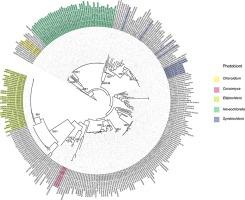Molecular Phylogenetics and Evolution ( IF 4.1 ) Pub Date : 2020-05-28 , DOI: 10.1016/j.ympev.2020.106860 Hanna Lindgren 1 , Bibiana Moncada 2 , Robert Lücking 3 , Nicolas Magain 4 , Antoine Simon 5 , Bernard Goffinet 6 , Emmanuël Sérusiaux 5 , Matthew P Nelsen 1 , Joel A Mercado-Díaz 7 , Todd J Widhelm 1 , H Thorsten Lumbsch 1

|
Species in the fungal genus Sticta form symbiotic associations primarily with either green algae or cyanobacteria, but tripartite associations or photosymbiodemes involving both types of photobionts occur in some species. Sticta is known to associate with green algae in the genus Symbiochloris. However, previous studies have shown that algae from other genera, such as Heveochlorella, may also be suitable partners for Sticta. We examined the diversity of green algal partners in the genus Sticta and assessed the patterns of association between the host fungus and its algal symbiont.
We used multi-locus sequence data from multiple individuals collected in Australia, Cuba, Madagascar, Mauritius, New Zealand, Reunion and South America to infer phylogenies for fungal and algal partners and performed tests of congruence to assess coevolution between the partners. In addition, event-based methods were implemented to examine which cophylogenetic processes have led to the observed association patterns in Sticta and its green algal symbionts. Our results show that in addition to Symbiochloris, Sticta associates with green algae from the genera Chloroidium, Coccomyxa, Elliptochloris and Heveochlorella, the latter being the most common algal symbiont associated with Sticta in this study. Geography plays a strong role in shaping fungal-algal association patterns in Sticta as mycobionts associate with different algal lineages in different geographic locations. While fungal and algal phylogenies were mostly congruent, event-based methods did not find any evidence for cospeciation between the partners. Instead, the association patterns observed in Sticta and associated algae, were largely explained by other cophylogenetic events such as host-switches, losses of symbiont and failure of the symbiont to diverge with its host. Our results also show that tripartite associations with green algae evolved multiple times in Sticta.
中文翻译:

藻类共生体中的cocoogenetic模式与Sticta属(地囊菌,伞形科)地衣形成真菌的多样化和地理扩展过程中重复的共生体转换有关。
真菌Sticta属中的物种主要与绿藻或蓝细菌形成共生缔合,但在某些物种中会发生涉及这两种类型的光合生物的三方缔合或光生生物灭亡。已知Sticta与Symbiochloris属中的绿藻有关。但是,先前的研究表明,其他属的藻类(例如绿藻)也可能是Sticta的合适伴侣。我们检查了Sticta属中绿色藻类伙伴的多样性,并评估了宿主真菌与其藻类共生体之间的缔合模式。
我们使用了来自澳大利亚,古巴,马达加斯加,毛里求斯,新西兰,留尼汪和南美的多个人的多基因座序列数据来推断真菌和藻类伴侣的系统发育,并进行一致性测试以评估伴侣之间的共进化。另外,还采用了基于事件的方法来检查哪些系统发生过程导致了Sticta及其绿色藻类共生体中观察到的缔合模式。我们的研究结果表明,除了Symbiochloris,Sticta同伙从属绿藻Chloroidium,胶球藻,Elliptochloris和Heveochlorella,后者是本研究中与Sticta相关的最常见的藻类共生体。地理在塑造Sticta中的真菌-藻类缔合模式方面发挥了重要作用,因为真菌菌与不同地理位置的不同藻类谱系相关。尽管真菌和藻类系统发育大多是一致的,但基于事件的方法并未发现任何证据表明伴侣之间存在共存关系。取而代之的是,在Sticta和相关藻类中观察到的缔合模式很大程度上是由其他系统发生事件解释的,例如宿主转换,共生体丧失和共生体与其宿主发散失败。我们的研究结果还表明,在Sticta中,三方与绿藻的关联演化了多次。


























 京公网安备 11010802027423号
京公网安备 11010802027423号